Yamaha FJR1300AS(C), FJR1300S(C) user guide
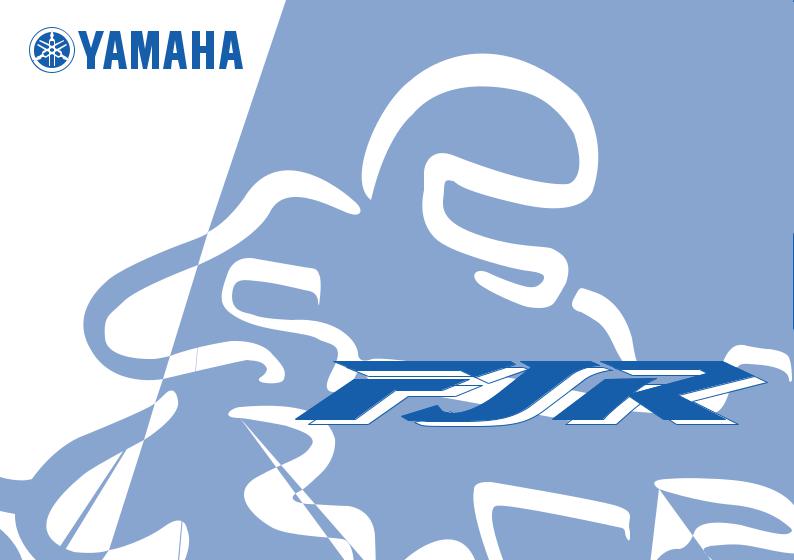
OWNER’S MANUAL
FJR1300S(C)
FJR1300AS(C)
LIT-11626-17-27 |
5JW-28199-11 |
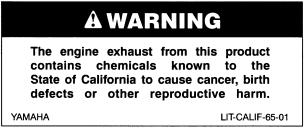
EAU10041

INTRODUCTION
EAU10080
Congratulations on your purchase of the Yamaha FJR1300S(C)/FJR1300AS(C). This model is the result of Yamaha’s vast experience in the production of fine sporting, touring, and pacesetting racing machines. It represents the high degree of craftsmanship and reliability that have made Yamaha a leader in these fields.
This manual will give you an understanding of the operation, inspection, and basic maintenance of this motorcycle. If you have any questions concerning the operation or maintenance of your motorcycle, please consult a Yamaha dealer.
The design and manufacture of this Yamaha motorcycle fully comply with the emissions standards for clean air applicable at the date of manufacture. Yamaha has met these standards without reducing the performance or economy of operation of the motorcycle. To maintain these high standards, it is important that you and your Yamaha dealer pay close attention to the recommended maintenance schedules and operating instructions contained within this manual.
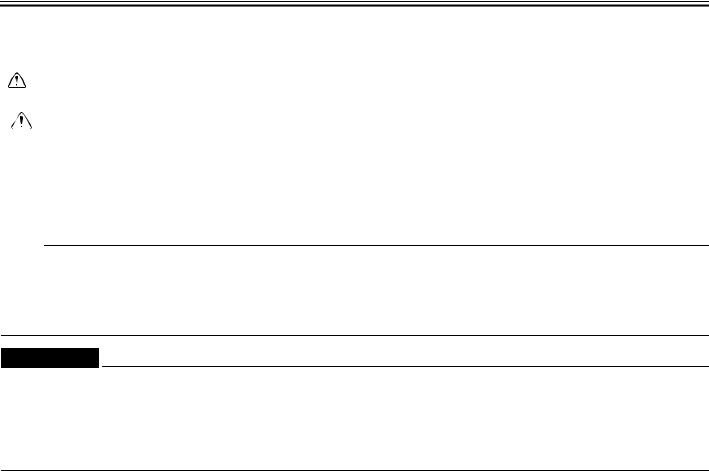
IMPORTANT MANUAL INFORMATION
EAU10130
Particularly important information is distinguished in this manual by the following notations:
|
|
|
|
The Safety Alert Symbol means ATTENTION! BECOME ALERT! YOUR SAFETY IS INVOLVED! |
|
|
|
|
|
|
|
|
|
|
|
|
|
|
Failure to follow WARNING instructions could result in severe injury or death to the motor- |
|
WARNING |
|
||
|
|
cycle operator, a bystander or a person inspecting or repairing the motorcycle. |
||
|
|
|
|
|
|
|
|
|
|
|
|
|
|
|
|
|
|
|
A CAUTION indicates special precautions that must be taken to avoid damage to the motor- |
|
CAUTION: |
|
|
|
|
|
cycle. |
||
|
|
|
|
|
|
|
|
|
|
NOTE: |
A NOTE provides key information to make procedures easier or clearer. |
|
|
NOTE:
●This manual should be considered a permanent part of this motorcycle and should remain with it even if the motorcycle is subsequently sold.
●Yamaha continually seeks advancements in product design and quality. Therefore, while this manual contains the most current product information available at the time of printing, there may be minor discrepancies between your motorcycle and this manual. If you have any questions concerning this manual, please consult your Yamaha dealer.
EWA10010
 WARNING
WARNING
PLEASE READ THIS MANUAL AND THE “YOU AND YOUR MOTORCYCLE: RIDING TIPS” BOOKLET CAREFULLY AND COMPLETELY BEFORE OPERATING THIS MOTORCYCLE. DO NOT ATTEMPT TO OPERATE THIS MOTORCYCLE UNTIL YOU HAVE ATTAINED ADEQUATE KNOWLEDGE OF ITS CONTROLS AND OPERATING FEATURES AND UNTIL YOU HAVE BEEN TRAINED IN SAFE AND PROPER RIDING TECHNIQUES. REGULAR INSPECTIONS AND CAREFUL MAINTENANCE, ALONG WITH GOOD RIDING SKILLS, WILL ENSURE THAT YOU SAFELY ENJOY THE CAPABILITIES AND THE RELIABILITY OF THIS MOTORCYCLE.
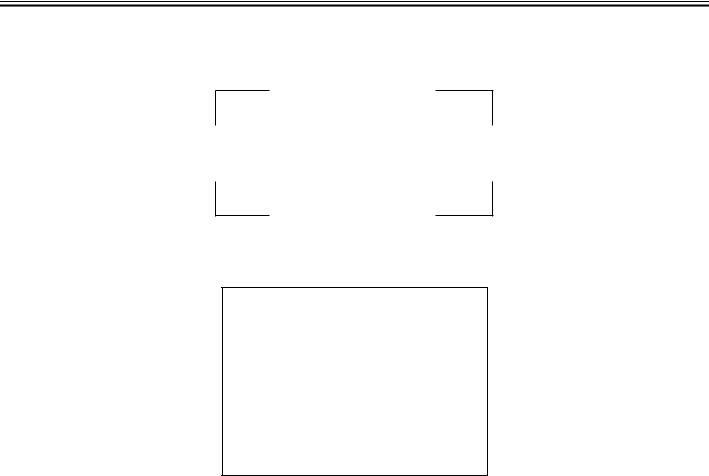
IMPORTANT MANUAL INFORMATION
EAU10191
AFFIX DEALER
LABEL HERE
FJR1300S(C)/FJR1300AS(C)
OWNER’S MANUAL
©2003 by Yamaha Motor Corporation, U.S.A.
1st edition, April 2003 All rights reserved.
Any reprinting or unauthorized use without the written permission of Yamaha Motor Corporation, U.S.A. is expressly prohibited.
Printed in Japan.
P/N LIT-11626-17-27

TABLE OF CONTENTS
SAFETY INFORMATION .................. |
1-1 |
Location of important labels ............ |
1-5 |
DESCRIPTION .................................. |
2-1 |
Left view .......................................... |
2-1 |
Right view ........................................ |
2-2 |
Controls and instruments................. |
2-3 |
INSTRUMENT AND CONTROL |
|
FUNCTIONS ....................................... |
3-1 |
Main switch/steering lock ................ |
3-1 |
Indicator and warning lights ............ |
3-2 |
Speedometer .................................. |
3-3 |
Tachometer .................................... |
3-3 |
Multi-function display ...................... |
3-4 |
Handlebar switches ........................ |
3-5 |
Clutch lever ..................................... |
3-7 |
Shift pedal ....................................... |
3-7 |
Brake lever ..................................... |
3-8 |
Brake pedal .................................... |
3-8 |
ABS (For FJR1300A only) ............... |
3-8 |
Fuel tank cap .................................. |
3-9 |
Fuel ............................................... |
3-10 |
Catalytic converter ........................ |
3-11 |
Seats ............................................ |
3-11 |
Storage compartment ................... |
3-12 |
Accessory box .............................. |
3-12 |
Adjusting the front fork .................. |
3-13 |
Adjusting the shock absorber |
|
assembly ................................... |
3-15 |
Locks for the optional side cases |
|
and travel trunk ......................... |
3-16 |
Sidestand ..................................... |
3-16 |
Ignition circuit cut-off system ........ |
3-17 |
PRE-OPERATION CHECKS ............. |
4-1 |
Pre-operation check list .................. |
4-2 |
OPERATION AND IMPORTANT |
|
RIDING POINTS................................. |
5-1 |
Starting the engine ......................... |
5-1 |
Shifting ........................................... |
5-2 |
Engine break-in .............................. |
5-3 |
Parking ........................................... |
5-4 |
PERIODIC MAINTENANCE AND |
|
MINOR REPAIR ................................. |
6-1 |
PERIODIC MAINTENANCE ........... |
6-1 |
Owner’s tool kit ............................... |
6-1 |
Periodic maintenance chart for the |
|
emission control system ............. |
6-3 |
General maintenance and |
|
lubrication chart .......................... |
6-4 |
Removing and installing panels ..... |
6-8 |
Checking the spark plugs ............. |
6-10 |
Canister (for California only) ........ |
6-11 |
Engine oil and oil filter cartridge ... |
6-11 |
Final gear oil ................................. |
6-14 |
Coolant ......................................... |
6-15 |
Cleaning the air filter element ...... |
6-16 |
Adjusting the throttle cable |
|
free play .................................... |
6-18 |
Adjusting the valve clearance ...... |
6-18 |
Tires ............................................. |
6-18 |
Cast wheels ................................. |
6-21 |
Accessories and replacement |
|
parts ......................................... |
6-21 |
Clutch lever free play ................... |
6-22 |
Adjusting the brake pedal |
|
position ..................................... |
6-22 |
Adjusting the rear brake light |
|
switch ....................................... |
6-23 |
Checking the front and rear |
|
brake pads ................................ |
6-23 |
Checking the brake and clutch fluid |
|
levels ........................................ |
6-24 |
Changing the brake and clutch |
|
fluids ......................................... |
6-25 |
Checking and lubricating the |
|
cables ....................................... |
6-26 |
Checking and lubricating the |
|
throttle grip and cable ............... |
6-26 |
Checking and lubricating the |
|
brake and shift pedals .............. |
6-26 |
Checking and lubricating the |
|
brake and clutch levers ............ |
6-27 |
Checking and lubricating the |
|
centerstand and sidestand ....... |
6-28 |
Lubricating the rear suspension ... |
6-28 |
Checking the front fork ................. |
6-28 |
Checking the steering .................. |
6-29 |

TABLE OF CONTENTS
Checking the wheel bearings ....... |
6-30 |
Battery .......................................... |
6-30 |
Replacing the fuses ...................... |
6-31 |
Replacing a headlight bulb ........... |
6-33 |
Replacing a rear turn signal light |
|
bulb or a tail/brake light bulb ..... |
6-34 |
Troubleshooting ............................ |
6-35 |
Troubleshooting charts ................. |
6-36 |
MOTORCYCLE CARE AND |
|
STORAGE .......................................... |
7-1 |
Care ................................................ |
7-1 |
Storage ........................................... |
7-3 |
SPECIFICATIONS ............................. |
8-1 |
CONSUMER INFORMATION............. |
9-1 |
Identification numbers .................... |
9-1 |
Reporting safety defects ................. |
9-3 |
Motorcycle noise regulation ............ |
9-4 |
Maintenance record ........................ |
9-5 |
YAMAHA MOTOR CORPORATION, |
|
U.S.A. STREET AND ENDURO |
|
MOTORCYCLE LIMITED |
|
WARRANTY ............................... |
9-7 |
YAMAHA EXTENDED SERVICE |
|
(Y.E.S.) ....................................... |
9-9 |

 SAFETY INFORMATION
SAFETY INFORMATION
EAU10250
MOTORCYCLES ARE SINGLE
1TRACK VEHICLES. THEIR SAFE USE AND OPERATION ARE DEPENDENT UPON THE USE OF PROPER RIDING TECHNIQUES AS WELL AS THE EXPERTISE OF THE OPERATOR. EVERY OPERATOR SHOULD KNOW THE FOLLOWING REQUIREMENTS BEFORE RIDING THIS MOTORCYCLE.
HE OR SHE SHOULD:
●OBTAIN THOROUGH INSTRUCTIONS FROM A COMPETENT SOURCE ON ALL ASPECTS OF MOTORCYCLE OPERATION.
●OBSERVE THE WARNINGS AND MAINTENANCE REQUIREMENTS IN THE OWNER’S MANUAL.
●OBTAIN QUALIFIED TRAINING IN SAFE AND PROPER RIDING TECHNIQUES.
●OBTAIN PROFESSIONAL TECHNICAL SERVICE AS INDICATED BY THE OWNER’S MANUAL
AND/OR WHEN MADE NECESSARY BY MECHANICAL CONDITIONS.
Safe riding
●Always make pre-operation checks. Careful checks may help prevent an accident.
●This motorcycle is designed to carry the operator and a passenger.
●The failure of motorists to detect and recognize motorcycles in traffic is the predominating cause of automobile/motorcycle accidents. Many accidents have been caused by an automobile driver who did not see the motorcycle. Making yourself conspicuous appears to be very effective in reducing the chance of this type of accident.
Therefore:
•Wear a brightly colored jacket.
•Use extra caution when approaching and passing through intersections, since intersections are the most likely places for motorcycle accidents to occur.
•Ride where other motorists can see you. Avoid riding in another motorist’s blind spot.
●Many motorcycle accidents involve inexperienced operators. In fact, many operators who have been involved in accidents do not even have a current motorcycle license.
•Make sure that you are qualified and that you only lend your motorcycle to other qualified operators.
•Know your skills and limits. Staying within your limits may help you to avoid an accident.
•We recommend that you practice riding your motorcycle where there is no traffic until you have become thoroughly familiar with the motorcycle and all of its controls.
●Many motorcycle accidents have been caused by error of the motorcycle operator. A typical error made by the operator is veering
1-1

 SAFETY INFORMATION
SAFETY INFORMATION
wide on a turn due to EXCESSIVE SPEED or undercornering (insufficient lean angle for the speed).
•Always obey the speed limit and never travel faster than warranted by road and traffic conditions.
•Always signal before turning or changing lanes. Make sure that other motorists can see you.
●The posture of the operator and passenger is important for proper control.
•The operator should keep both hands on the handlebar and both feet on the operator footrests during operation to maintain control of the motorcycle.
•The passenger should always hold onto the operator, seat strap, or grab bar, if equipped, with both hands and keep both feet on the passenger footrests.
•Never carry a passenger unless he or she can firmly place both feet on the passenger footrests.
●Never ride under the influence of alcohol or other drugs.
●This motorcycle is designed for onroad use only, therefore, it is not suitable for off-road use.
Protective apparel
The majority of fatalities from motorcycle accidents are the result of head injuries. The use of a safety helmet is the single most critical factor in the prevention or reduction of head injuries.
●Always wear an approved helmet.
●Wear a face shield or goggles. Wind in your unprotected eyes could contribute to an impairment of vision which could delay seeing a hazard.
●The use of a jacket, heavy boots, trousers, gloves, etc., is effective in preventing or reducing abrasions or lacerations.
●Never wear loose-fitting clothes, otherwise they could catch on the control levers, footrests, or wheels and cause injury or an accident.
●Never touch the engine or exhaust system during or after operation. They become very hot and can
cause burns. Always wear protective clothing that covers your legs, ankles, and feet.
● Passengers should also observe 1 the precautions mentioned above.
Modifications
Modifications made to this motorcycle not approved by Yamaha, or the removal of original equipment, may render the motorcycle unsafe for use and may cause severe personal injury. Modifications may also make your motorcycle illegal to use.
Loading and accessories
Adding accessories or cargo to your motorcycle can adversely affect stability and handling if the weight distribution of the motorcycle is changed. To avoid the possibility of an accident, use extreme caution when adding cargo or accessories to your motorcycle. Use extra care when riding a motorcycle that has added cargo or accessories. Here are some general guidelines to follow if loading cargo or adding accessories to your motorcycle:
1-2

 SAFETY INFORMATION
SAFETY INFORMATION
Loading
The total weight of the operator, passenger, accessories and cargo must
1not exceed the maximum load limit of FJR1300 200.0 kg (441 lb) (CAL) FJR1300 201.0 kg (443 lb) (U49) FJR1300A 193.0 kg (426 lb) (CAL) FJR1300A 194.0 kg (428 lb) (U49). When loading within this weight limit, keep the following in mind:
●Cargo and accessory weight should be kept as low and close to the motorcycle as possible. Make sure to distribute the weight as evenly as possible on both sides of the motorcycle to minimize imbalance or instability.
●Shifting weights can create a sudden imbalance. Make sure that accessories and cargo are securely attached to the motorcycle before riding. Check accessory mounts and cargo restraints frequently.
●Never attach any large or heavy items to the handlebar, front fork, or front fender. These items, including such cargo as sleeping
bags, duffel bags, or tents, can create unstable handling or slow steering response.
Accessories
Genuine Yamaha accessories have been specifically designed for use on this motorcycle. Since Yamaha cannot test all other accessories that may be available, you must personally be responsible for the proper selection, installation and use of non-Yamaha accessories. Use extreme caution when selecting and installing any accessories.
Keep the following guidelines in mind, as well as those provided under “Loading” when mounting accessories.
●Never install accessories or carry cargo that would impair the performance of your motorcycle. Carefully inspect the accessory before using it to make sure that it does not in any way reduce ground clearance or cornering clearance,
limit suspension travel, steering travel or control operation, or obscure lights or reflectors.
•Accessories fitted to the handlebar or the front fork area can create instability due to improper weight distribution or aerodynamic changes. If accessories are added to the handlebar or front fork area, they must be as lightweight as possible and should be kept to a minimum.
•Bulky or large accessories may seriously affect the stability of the motorcycle due to aerodynamic effects. Wind may attempt to lift the motorcycle, or the motorcycle may become unstable in cross winds. These accessories may also cause instability when passing or being passed by large vehicles.
•Certain accessories can displace the operator from his or her normal riding position. This improper position limits the freedom of movement of the opera-
1-3

 SAFETY INFORMATION
SAFETY INFORMATION
tor and may limit control ability, therefore, such accessories are not recommended.
●Use caution when adding electrical accessories. If electrical accessories exceed the capacity of the motorcycle’s electrical system, an electric failure could result, which could cause a dangerous loss of lights or engine power.
Gasoline and exhaust gas
●GASOLINE IS HIGHLY FLAMMABLE:
•Always turn the engine off when refueling.
•Take care not to spill any gasoline on the engine or exhaust system when refueling.
•Never refuel while smoking or in the vicinity of an open flame.
●Never start the engine or let it run for any length of time in a closed area. The exhaust fumes are poisonous and may cause loss of consciousness and death within a short time. Always operate your motorcycle in an area that has adequate ventilation.
●Always turn the engine off before leaving the motorcycle unattended and remove the key from the main switch. When parking the motorcycle, note the following:
•The engine and exhaust system may be hot, therefore, park the motorcycle in a place where pedestrians or children are not likely to touch these hot areas.
•Do not park the motorcycle on a slope or soft ground, otherwise it may fall over.
•Do not park the motorcycle near a flammable source (e.g. a kerosene heater, or near an open flame), otherwise it could catch fire.
●When transporting the motorcycle in another vehicle, make sure that it is kept upright and that the fuel cock is turned to “ON” or “RES” (for vacuum type) / “OFF” (for manual type). If it should lean over, gasoline may leak out of the carburetor or fuel tank.
●If you should swallow any gasoline, inhale a lot of gasoline vapor, or allow gasoline to get into your
1-4
eyes, see your doctor immediately. If any gasoline spills on your skin or clothing, immediately wash the
affected area with soap and water 1 and change your clothes.
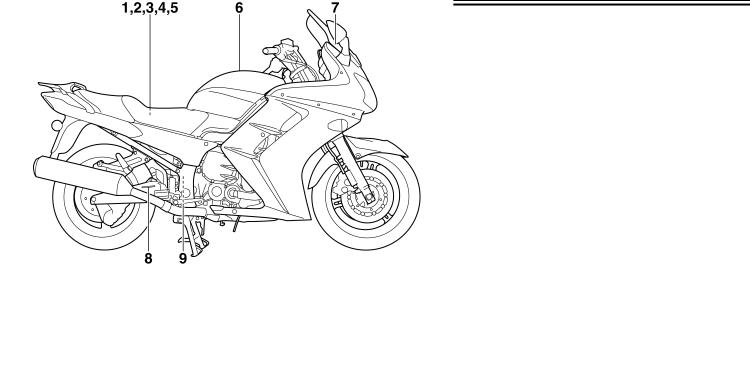
 SAFETY INFORMATION
SAFETY INFORMATION
EAU10381
Location of important labels
Please read the following important labels carefully before operating this vehicle.
1
1-5
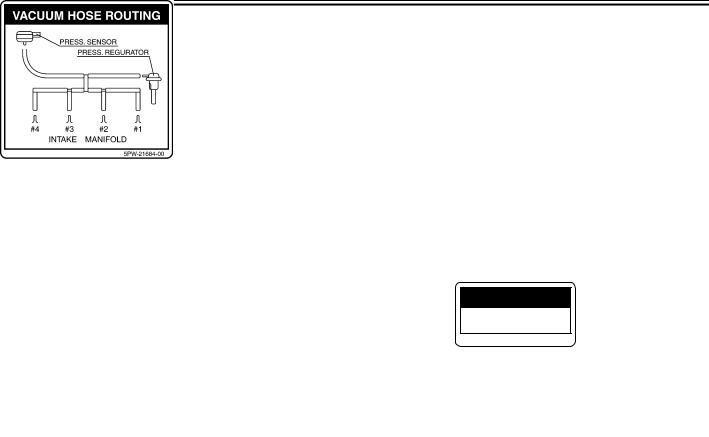
 SAFETY INFORMATION
SAFETY INFORMATION
1 |
3 |
1 |
|
|
|
2 California only
4
LOAD LIMIT
3 Kg (7 lbs)
3TB-24877-A0
1-6
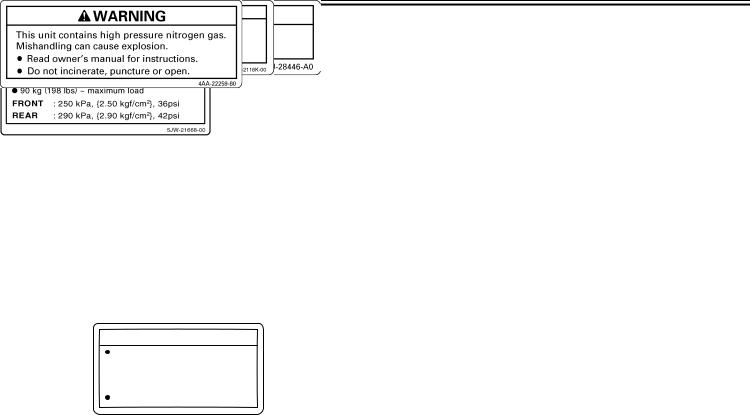
 SAFETY INFORMATION
SAFETY INFORMATION
1
5 |
8 |
6
9
7
CAUTION
Cleaning with alkaline or acid cleaner, gasoline or solvent will damage windshield.
Use neutral detergent.
5JW-00
1-7

DESCRIPTION
Left view
1.Fuse box (page 6-31)
2.Accessory box (page 3-12)
3.Front fork spring preload adjusting bolt (page 3-13)
4.Front fork rebound damping force adjusting knob (page 3-13)
5.Engine oil filler cap (page 6-11)
6.Owner’s tool kit (page 6-1)
7.Rider seat (page 3-11)
8.Passenger seat (page 3-11)
9.Carrier
EAU10410
2
10.Final gear oil filler bolt (page 6-14) 11.Final gear oil drain bolt (page 6-14)
12.Shock absorber assembly rebound damping force adjusting knob (page 3-15)
13.Shock absorber assembly spring preload adjusting lever (page 3-15) 14.Air filter element (page 6-16)
15.Shift pedal (page 3-7)
16.Engine oil filter cartridge (page 6-11) 17.Engine oil level check window (page 6-11)
2-1
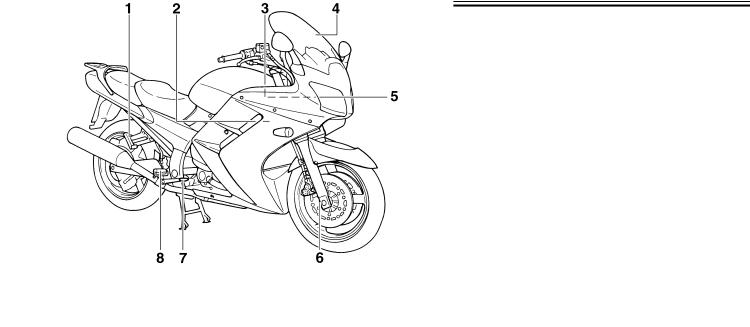
DESCRIPTION
EAU10420
Right view
2
1.Passenger footrest
2.Coolant reservoir (page 6-15)
3.Battery (page 6-30)
4.Windshield
5.Main fuse and electronic fuel injection fuse (page 6-31)
6.Front fork compression damping force adjusting screw (page 3-13)
7.Brake pedal (page 3-8)
8.Rider footrest
2-2
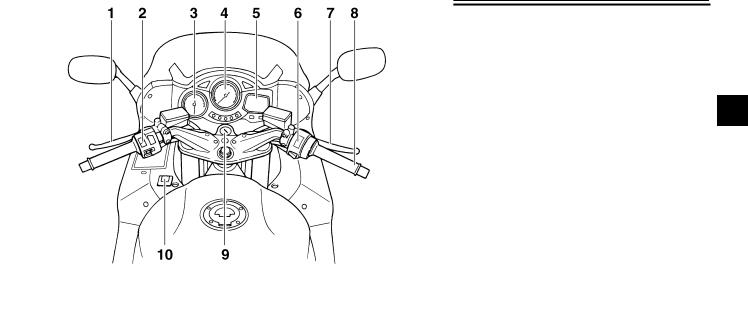
DESCRIPTION
EAU10430
Controls and instruments
2
1. |
Clutch lever (page 3-7) |
9. Main switch/steering lock (page 3-1) |
2. |
Left handlebar switch (page 3-5) |
10.Hazard switch (page 3-6) |
3.Tachometer (page 3-3)
4.Speedometer (page 3-3)
5.Multi-function display (page 3-4)
6.Right handlebar switches (page 3-5)
7.Brake lever (page 3-8)
8.Throttle grip (page 6-18)
2-3
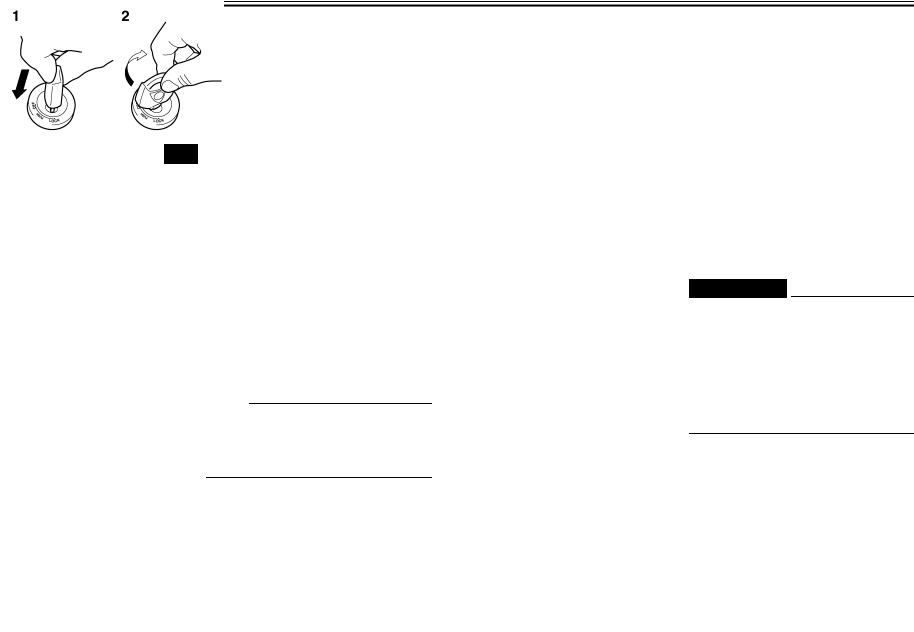
INSTRUMENT AND CONTROL FUNCTIONS
EAU10460
Main switch/steering lock
3
The main switch/steering lock controls the ignition and lighting systems, and is used to lock the steering. The various positions are described below.
EAU10580
ON
All electrical circuits are supplied with power, and the meter lighting, taillight and position lights come on, and the engine can be started. The key cannot be removed.
NOTE:
The headlight comes on automatically when the engine is started and stays on until the key is turned to “OFF”, even if the engine stalls.
EAU10660
OFF
All electrical systems are off. The key can be removed.
EAU10690
LOCK
The steering is locked, and all electrical systems are off. The key can be removed.
To lock the steering
1.Push.
2.Turn.
1.Turn the handlebars all the way to the left or right.
2.Push the key in from the “OFF” position, and then turn it to “LOCK” while still pushing it.
3.Remove the key.
To unlock the steering
1.Push.
2.Turn.
Push the key into the main switch, and then turn it to “OFF” while still pushing it.
EWA10060
 WARNING
WARNING
Never turn the key to “OFF” or “LOCK” while the vehicle is moving, otherwise the electrical systems will be switched off, which may result in loss of control or an accident. Make sure that the vehicle is stopped before turning the key to “OFF” or “LOCK”.
3-1
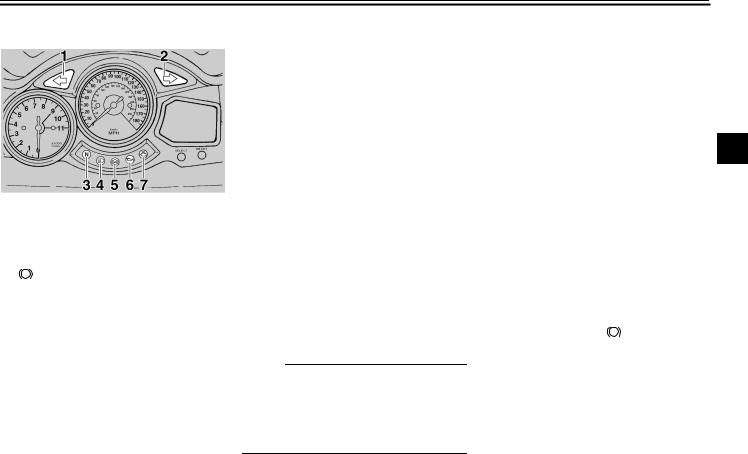
INSTRUMENT AND CONTROL FUNCTIONS
EAU11001
Indicator and warning lights
1.Left turn signal indicator light “ ”
”
2.Right turn signal indicator light “ ”
”
3.Neutral indicator light “  ”
”
4.High beam indicator light “  ”
”
5.Anti-lock Brake System (ABS) warning light
“ ABS ”
6.Oil level warning light “ 

 ”
”
7.Engine trouble warning light “  ”
”
EAU11030
Turn signal indicator lights “ ” and
” and
“ ”
”
The corresponding indicator light flashes when the turn signal switch is pushed to the left or right.
EAU11060
Neutral indicator light “  ”
”
This indicator light comes on when the transmission is in the neutral position.
EAU11080
High beam indicator light “ ”
”
This indicator light comes on when the high beam of the headlight is switched on.
EAU11120
Oil level warning light “

 ”
”
This warning light comes on when the engine oil level is low.
The electrical circuit of the warning light can be checked by turning the key to “ON”.
If the warning light does not come on for a few seconds, then go off, have a Yamaha dealer check the electrical circuit.
NOTE:
Even if the oil level is sufficient, the warning light may flicker when riding on a slope or during sudden acceleration or deceleration, but this is not a malfunction.
EAU11510
Engine trouble warning light “  ”
”
This warning light comes on when an electrical circuit monitoring the engine is defective. When this occurs, have a Yamaha dealer check the self-diagno- sis system.
This warning light also comes on when
the fuel tank is empty. If the warning 3 light does not go off after refueling, have a Yamaha dealer check the electrical circuit.
The electrical circuit of the warning light can be checked by turning the key to “ON”. If the warning light does not come on for a few seconds, then go off, have a Yamaha dealer check the electrical circuit.
EAU11542
ABS warning light “ ABS ”
If this warning light comes on or flashes while riding, the ABS may be defective. If this occurs, have a Yamaha dealer check the system as soon as possible. (See page 3-8.)
3-2
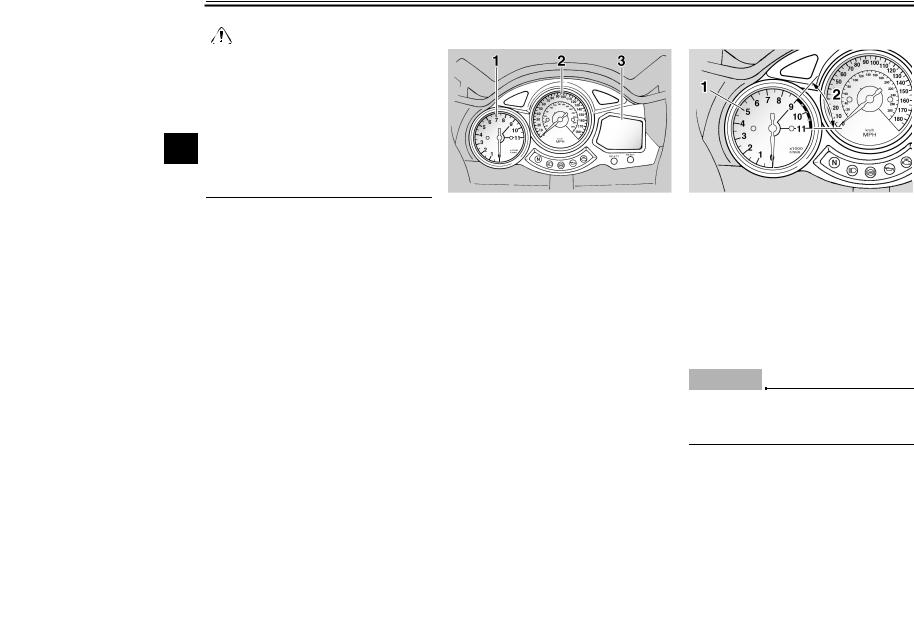
INSTRUMENT AND CONTROL FUNCTIONS
|
|
EWA10081 |
EAU11601 |
EAU11871 |
|
|
Speedometer |
Tachometer |
|||
WARNING |
|
|
|
||
If the ABS warning light comes on or flashes while riding, the brake system reverts to conventional braking. Therefore, be careful not to cause the wheels to lock during emergency braking. If the warning light
3comes on or flashes while riding, have a Yamaha dealer check the brake system as soon as possible.
The electrical circuit of the warning light can be checked by turning the key to “ON”.
If the warning light does not come on or remains on, have a Yamaha dealer check the electrical circuit.
1.Tachometer
2.Speedometer
3.Multi-function display
The speedometer shows the riding speed.
When the key is turned to “ON”, the speedometer needle will sweep once across the speed range and then return to zero km/h (mph) in order to test the electrical circuit.
1.Tachometer
2.Tachometer red zone
The electric tachometer allows the rider to monitor the engine speed and keep it within the ideal power range.
When the key is turned to “ON”, the tachometer needle will sweep once across the r/min range and then return to zero r/min in order to test the electrical circuit.
ECA10030
CAUTION:
Do not operate the engine in the tachometer red zone.
Red zone: 9000 r/min and above
3-3
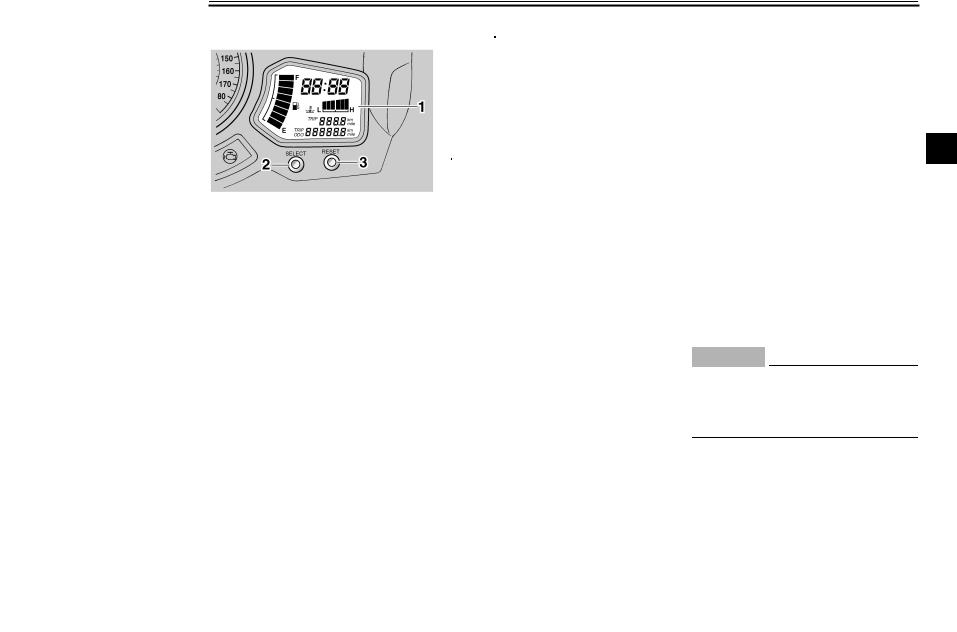
INSTRUMENT AND CONTROL FUNCTIONS
Multi-function display |
EAU12250 |
|||
NOTE: |
|
|
||
|
||||
|
|
● Be sure to turn the key to “ON” be- |
||
|
|
fore using the “SELECT” and “RE- |
||
|
|
SET” buttons. |
||
|
|
● To switch the speedometer display |
||
|
|
between kilometers and miles, |
||
|
|
press the “SELECT” button for at |
||
|
|
least two seconds. |
||
|
|
|
|
|
1.Multi-function display
2.“SELECT” button
3.“RESET” button
The multi-function display is equipped with the following:
●a fuel gauge
●a coolant temperature gauge
●an odometer (which shows the total distance traveled)
●two tripmeters (which show the distance traveled since they were last set to zero)
●a fuel reserve tripmeter (which shows the distance traveled on the fuel reserve)
●a self-diagnosis device
●a clock
Odometer and tripmeter modes
Pushing the “SELECT” button switches the display between the odometer mode “ODO” and the tripmeter modes “TRIP” in the following order:
ODO → TRIP (top) → TRIP (bottom) →ODO
When approximately 5.0 L (1.32 US gal) (1.10 Imp.gal) of fuel remains in the fuel tank, the display will automatically change to the fuel reserve tripmeter mode “TRIP F” and start counting the distance traveled from that point. In that case, pushing the “SELECT” button switches the display between the various tripmeter and odometer modes in the following order:
TRIP F → TRIP (top) → TRIP (bottom) → ODO → TRIP F
To reset a tripmeter, select it by pushing the “SELECT” button, and then push the “RESET” button for at least one second. If you do not reset the fuel reserve tripmeter manually, it will reset itself automatically and the display will return to the prior mode after refueling
and traveling 5 km (3 mi).
3
Self-diagnosis device
This model is equipped with a self-diag- nosis device for various electrical circuits.
If any of those circuits are defective, the clock will indicate a two-digit error code (e.g., 11, 12, 13).
If the clock indicates such an error code, note the code number, and then have a Yamaha dealer check the vehicle.
ECA11360
CAUTION:
If the clock indicates an error code, the vehicle should be checked as soon as possible in order to avoid engine damage.
3-4
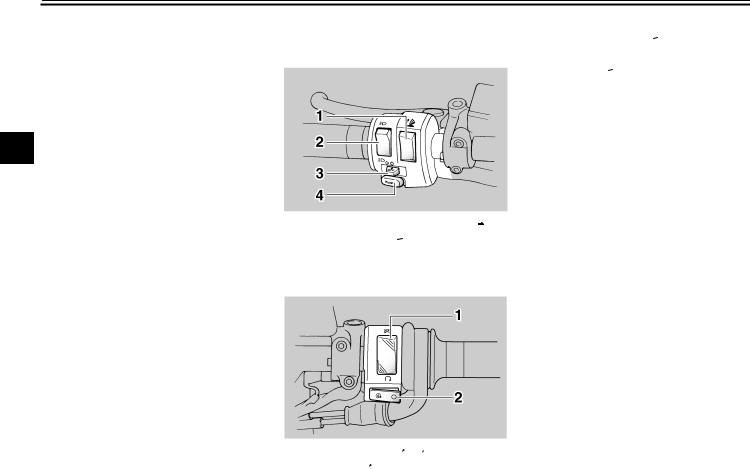
INSTRUMENT AND CONTROL FUNCTIONS
Clock mode
To set the clock:
1.Push the “SELECT” button and “RESET” button together for at least two seconds.
2.When the hour digits start flashing, push the “RESET” button to set the hours.
33. Push the “SELECT” button, and the minute digits will start flashing.
4.Push the “RESET” button to set the minutes.
5.Push the “SELECT” button and then release it to start the clock.
EAU12341
Handlebar switches
Left
1.Windshield position adjusting switch “ ”
”
2.Dimmer switch “  /
/ ”
”
3.Turn signal switch “ /
/ ”
”
4.Horn switch “  ”
”
EAU12400
Dimmer switch “ /
/ ”
”
Set this switch to “ ” for the high beam and to “
” for the high beam and to “ ” for the low beam.
” for the low beam.
EAU12460
Turn signal switch “ /
/ ”
”
To signal a right-hand turn, push this switch to “ ”. To signal a left-hand turn, push this switch to “
”. To signal a left-hand turn, push this switch to “ ”. When released, the switch returns to the center position. To cancel the turn signal lights, push the switch in after it has returned to the center position.
”. When released, the switch returns to the center position. To cancel the turn signal lights, push the switch in after it has returned to the center position.
Right
1.Engine stop switch “ /
/ ”
”
2.Start switch “ ”
”
3-5
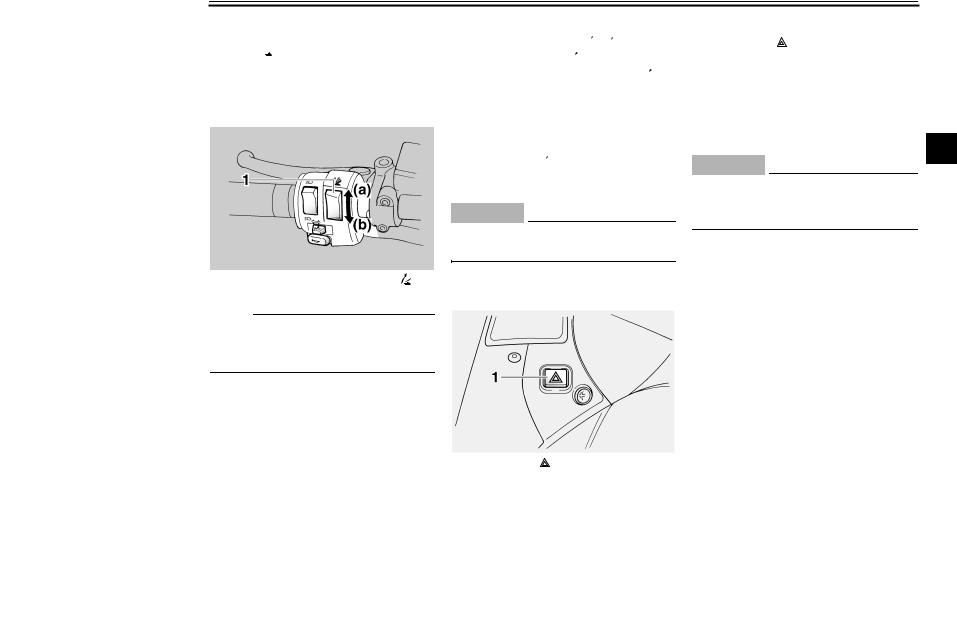
INSTRUMENT AND CONTROL FUNCTIONS
EAU12492
Windshield position adjusting switch “ ”
”
To move the windshield up, push this switch in direction (a). To move the windshield down, push the switch in direction (b).
EAU12660
Engine stop switch “ /
/ ”
”
Set this switch to “ ” before starting the engine. Set this switch to “
” before starting the engine. Set this switch to “ ” to stop the engine in case of an emergency, such as when the vehicle overturns or when the throttle cable is stuck.
” to stop the engine in case of an emergency, such as when the vehicle overturns or when the throttle cable is stuck.
EAU12710
Start switch “ ”
”
Push this switch to crank the engine with the starter.
ECA10050
CAUTION:
See page 5-1 for starting instructions prior to starting the engine.
1. Windshield position adjusting switch “  ”
”
EAU12763
Hazard switch “ ”
”
NOTE:
When the engine is turned off, the windshield will automatically return to the lowest position.
EAU12500
Horn switch “  ”
”
Press this switch to sound the horn.
With the key in the “ON” position, turn this switch to “ ” to turn on the hazard lights (simultaneous flashing of all turn signal lights).
The hazard lights are used in case of an emergency or to warn other drivers when your vehicle is stopped where it might be a traffic hazard.
ECA10060 3
CAUTION:
Do not use the hazard light for an extended length of time, otherwise the battery may discharge.
1. Hazard switch “ ”
3-6

INSTRUMENT AND CONTROL FUNCTIONS
Clutch lever
3
EAU12830 |
Make sure that the appropriate setting |
EAU12870 |
|
on the adjusting dial is aligned with the |
Shift pedal |
|
|
arrow mark on the clutch lever. |
|
The clutch lever is equipped with a |
|
clutch switch, which is part of the igni- |
|
tion circuit cut-off system. (See page |
|
3-17.) |
|
1.Clutch lever
2.Arrow mark
3.Clutch lever position adjusting dial
4.Distance between clutch lever and handlebar grip
The clutch lever is located at the left handlebar grip. To disengage the clutch, pull the lever toward the handlebar grip. To engage the clutch, release the lever. The lever should be pulled rapidly and released slowly for smooth clutch operation.
The clutch lever is equipped with a clutch lever position adjusting dial. To adjust the distance between the clutch lever and the handlebar grip, turn the adjusting dial while holding the lever pushed away from the handlebar grip.
1. Shift pedal
The shift pedal is located on the left side of the engine and is used in combination with the clutch lever when shifting the gears of the 5-speed con- stant-mesh transmission equipped on this motorcycle.
3-7
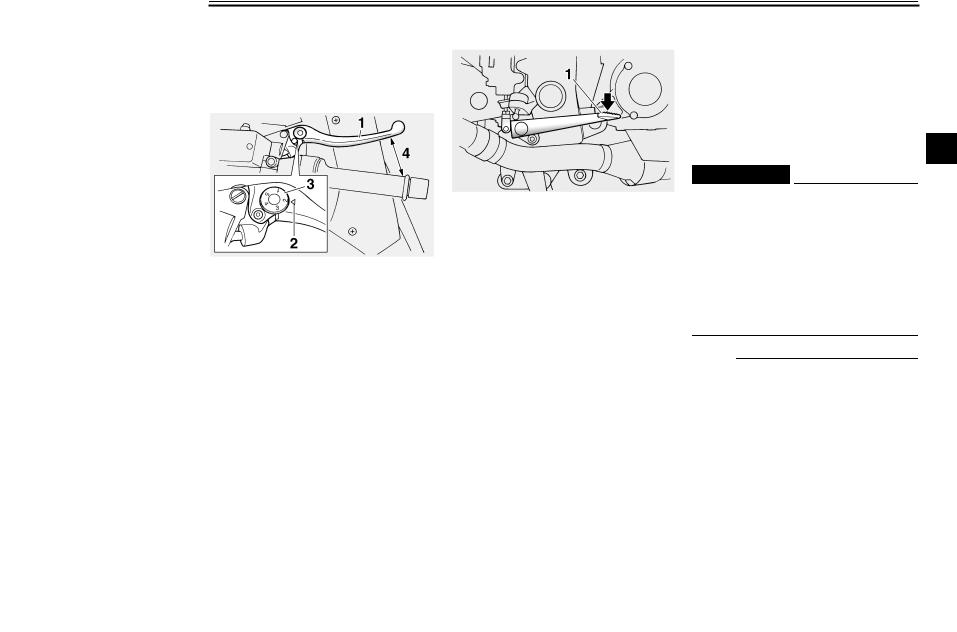
INSTRUMENT AND CONTROL FUNCTIONS
EAU12930
Brake lever
The brake lever is located at the right handlebar grip. To apply the front brake, pull the lever toward the handlebar grip.
1.Brake lever
2.Arrow mark
3.Brake lever position adjusting dial
4.Distance between brake lever and handlebar grip
The brake lever is equipped with a position adjusting dial. To adjust the distance between the brake lever and the handlebar grip, turn the adjusting dial while holding the lever pushed away from the handlebar grip. Make sure that the appropriate setting on the adjusting dial is aligned with the arrow mark on the brake lever.
EAU12941
Brake pedal
1. Brake pedal
The brake pedal is on the right side of the motorcycle. To apply the rear brake, press down on the brake pedal.
EAU26791
ABS (For FJR1300A only)
The Yamaha ABS (Anti-lock Brake System) features a dual electronic control system, which acts on the front and rear brakes independently. The ABS is monitored by an ECU (Electronic Control Unit), which will have recourse to
manual braking if a malfunction occurs. 3
EWA10090
 WARNING
WARNING
●The ABS performs best on long braking distances.
●On certain (rough or gravel) roads, the braking distance may be longer with than without the ABS. Therefore, always keep a sufficient distance to the vehicle ahead to match the riding speed.
NOTE:
●When the ABS is activated, the brakes are operated in the usual way. A pulsating action may be felt at the brake lever or brake pedal, but this does not indicate a malfunction.
3-8
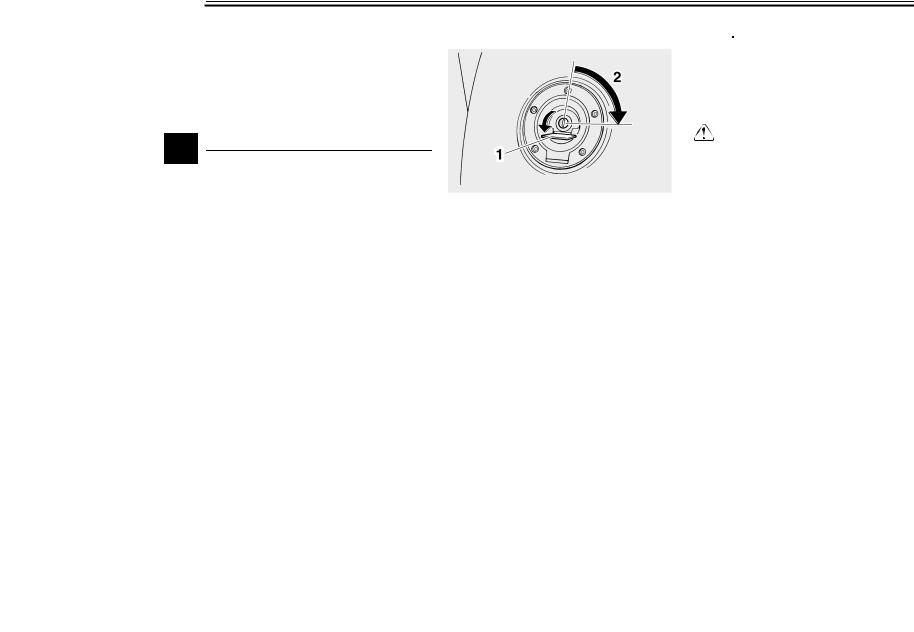
INSTRUMENT AND CONTROL FUNCTIONS
●This ABS has a test mode which allows the owner to experience the pulsating at the brake lever or brake pedal when the ABS is operating. However, special tools are required, so please consult your Yamaha dealer when performing this test.
3
Fuel tank cap |
EAU13070 |
|||||
NOTE: |
|
|
|
|
||
|
|
|
||||
|
|
The fuel tank cap cannot be closed un- |
||||
|
|
less the key is in the lock. In addition, |
||||
|
|
the key cannot be removed if the cap is |
||||
|
|
not properly closed and locked. |
||||
|
|
|
|
|
|
|
|
|
|
|
|
EWA11090 |
|
|
|
WARNING |
|
|
|
|
|
|
Make sure that the fuel tank cap is |
||||
|
|
properly closed before riding. |
||||
|
|
|
|
|
|
|
1.Fuel tank cap lock cover
2.Unlock.
To open the fuel tank cap
Open the fuel tank cap lock cover, insert the key into the lock, and then turn it 1/4 turn clockwise. The lock will be released and the fuel tank cap can be opened.
To close the fuel tank cap
1.Push the fuel tank cap into position with the key inserted in the lock.
2.Turn the key counterclockwise to the original position, remove it, and then close the lock cover.
3-9
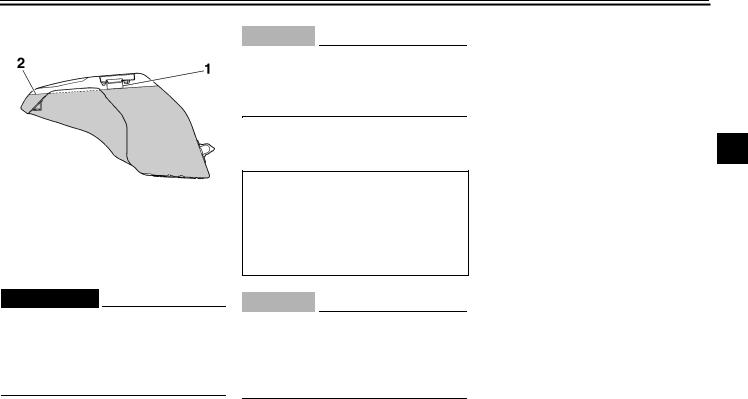
INSTRUMENT AND CONTROL FUNCTIONS
EAU13210
Fuel
1.Fuel tank filler tube
2.Fuel level
Make sure that there is sufficient fuel in the tank. Fill the fuel tank to the bottom of the filler tube as shown.
EWA10880
 WARNING
WARNING
ECA10070
CAUTION:
Immediately wipe off spilled fuel with a clean, dry, soft cloth, since fuel may deteriorate painted surfaces or plastic parts.
EAU13360
Recommended fuel
UNLEADED GASOLINE ONLY
Fuel tank capacity:
25.0 L (6.61 US gal) (5.50 Imp.gal)
Fuel reserve amount (when the fuel level warning light comes on):
5.0 L (1.32 US gal) (1.10 Imp.gal)
ECA11400
CAUTION:
knocking (or pinging) occurs, use a gasoline of a different brand or premium unleaded fuel. Use of unleaded fuel will extend spark plug life and reduce maintenance costs.
Gasohol
There are two types of gasohol: gasohol containing ethanol and that contain-
ing methanol. Gasohol containing 3 ethanol can be used if the ethanol con-
tent does not exceed 10%. Gasohol containing methanol is not recommended by Yamaha because it can cause damage to the fuel system or vehicle performance problems.
●Do not overfill the fuel tank, otherwise it may overflow when the fuel warms up and expands.
●Avoid spilling fuel on the hot engine.
Use only unleaded gasoline. The use of leaded gasoline will cause severe damage to internal engine parts, such as the valves and piston rings, as well as to the exhaust system.
Your Yamaha engine has been designed to use regular unleaded gasoline with a pump octane number [(R+M)/2] of 86 or higher, or a research octane number of 91 or higher. If
3-10
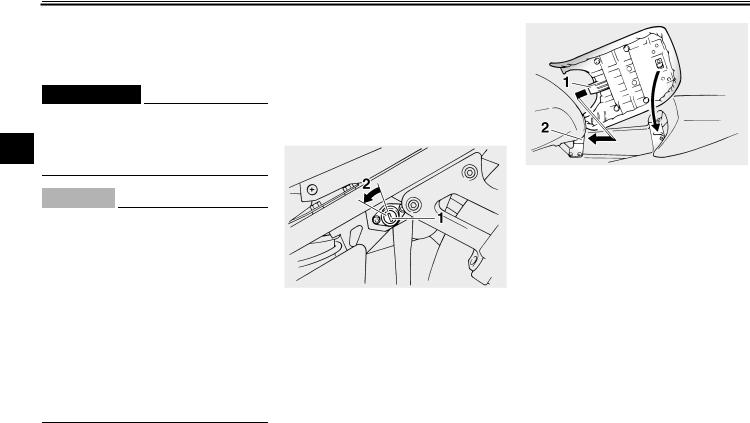
INSTRUMENT AND CONTROL FUNCTIONS
EAU13430
Catalytic converter
This model is equipped with a catalytic converter in the exhaust chamber.
EWA10860
 WARNING
WARNING
The exhaust system is hot after operation. Make sure that the exhaust
3system has cooled down before doing any maintenance work.
ECA10700
CAUTION:
The following precautions must be observed to prevent a fire hazard or other damages.
●Use only unleaded gasoline. The use of leaded gasoline will cause unrepairable damage to the catalytic converter.
●Never park the vehicle near possible fire hazards such as grass or other materials that easily burn.
●Do not allow the engine to idle too long.
EAU14080
Seats
Rider seat
To remove the rider seat
1.Insert the key into the seat lock, and then turn it as shown.
1.Rider seat lock
2.Unlock.
2.Pull the rider seat off.
To install the rider seat
1.Insert the projection on the front of the rider seat into the seat holder as shown, and then push the rear of the seat down to lock it in place.
1.Projection
2.Seat holder
2.Remove the key.
Passenger seat
To remove the passenger seat
1.Remove the rider seat.
2.Pull the passenger seat up.
To install the passenger seat
1.Slide the receptacle on the rear of the passenger seat over the seat holder as shown, and then push the front of the seat down.
3-11
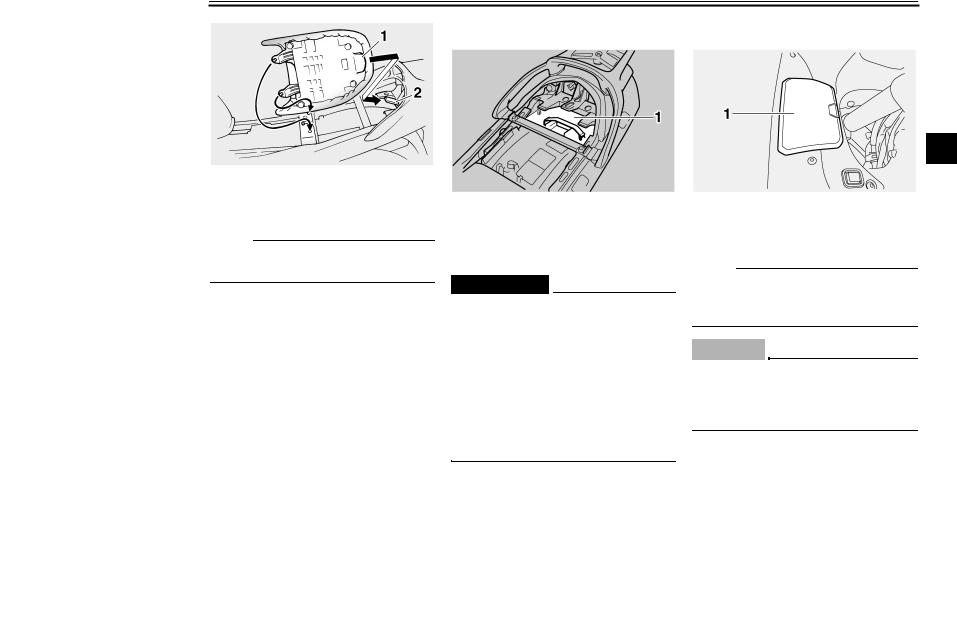
INSTRUMENT AND CONTROL FUNCTIONS
1.Receptacle
2.Seat holder
2.Install the rider seat.
NOTE:
Make sure that the seats are properly secured before riding.
EAU14461 |
EAU26881 |
Storage compartment |
Accessory box |
3
1. Storage compartment
The storage compartment is located under the passenger seat. (See page 3-11.)
EWA10961
 WARNING
WARNING
●Do not exceed the load limit of 3 kg (7 lb) for the storage compartment.
●Do not exceed the maximum load of
FJR1300 200.0 kg (441 lb) (CAL) FJR1300 201.0 kg (443 lb) (U49) FJR1300A 193.0 kg (426 lb) (CAL) FJR1300A 194.0 kg (428 lb) (U49) for the vehicle.
1. Accessory box
The accessory box is located beside the meter panel.
NOTE:
The accessory box can only be opened when the key is turned to “ON” and the transmission is in neutral.
ECA11800
CAUTION:
Do not place heat-sensitive items in the accessory box. The accessory box gets extremely hot especially when the engine is running or is hot.
3-12
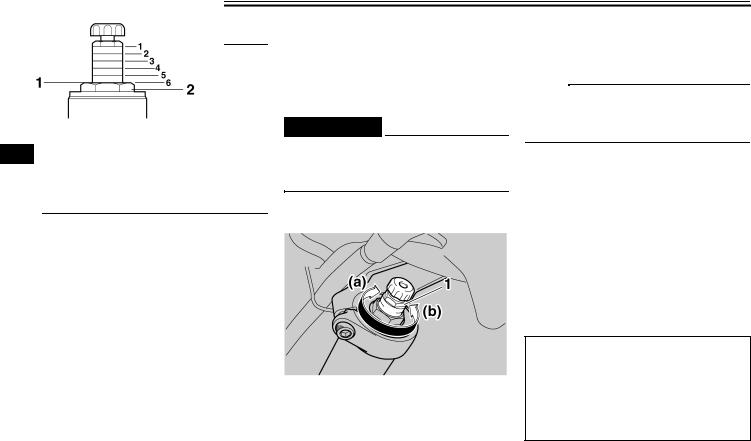
INSTRUMENT AND CONTROL FUNCTIONS
EWA11420
 WARNING
WARNING
●Do not exceed the load limit of 0.3 kg (0.7 lb) for the accessory box.
●Do not exceed the maximum load of
FJR1300 200.0 kg (441 lb) (CAL)
3FJR1300 201.0 kg (443 lb) (U49) FJR1300A 193.0 kg (426 lb) (CAL) FJR1300A 194.0 kg (428 lb) (U49) for the vehicle.
EAU14731
Adjusting the front fork
This front fork is equipped with spring preload adjusting bolts, rebound damping force adjusting knobs and compression damping force adjusting screws.
EWA10180
 WARNING
WARNING
Always adjust both fork legs equally, otherwise poor handling and loss of stability may result.
Spring preload
load and thereby soften the suspension, turn the adjusting bolt on each fork leg in direction (b).
NOTE:
Align the appropriate groove on the adjusting mechanism with the top of the front fork cap bolt.
1. Spring preload adjusting bolt
To increase the spring preload and thereby harden the suspension, turn the adjusting bolt on each fork leg in direction (a). To decrease the spring pre-
1.Current setting
2.Front fork cap bolt
Spring preload setting:
Minimum (soft): 6
Standard:
4
Maximum (hard): 1
3-13
